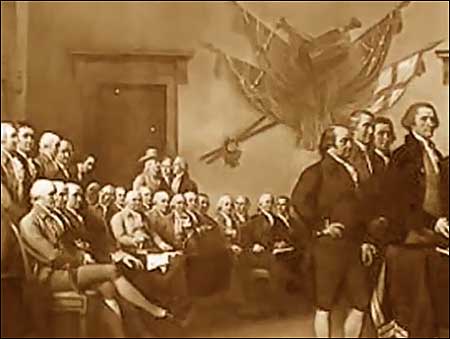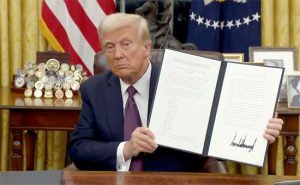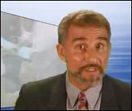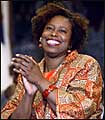A Summary of the Documentary Video “Overview of America”
updated September 17, 2022
A still image from the video documentary “Overview of America.”
This video describes aspects of the major types of government and economic systems that exist in the world, and it explains why the system of a capitalistic constitutional republic as outlined in the United States Constitution is preferable to other types of systems.
This video had been produced by The John Birch Society. Also see the article A Summary of the Booklet “Restoring the Rights of the States and the People”.
[Note: September 17, 2022— Typos in the text of this article have been fixed.]
Jump to segments from this video ..
Overview of America— Part 1 of 2: A Firm Foundation
Following are key points in the video clip:
— When the Founding Fathers declared independence from the British, they stated that the rights of men are given to them by God— including life, liberty, and the pursuit of happiness— and that government should be instituted in order to secure those rights.
— It is explained that the Founders designed the U.S. government to be a “negative force” that leaves people alone, with its sole function being to protect citizens from one another, foreign governments, and from the government itself— where it was not designed to be a “positive force” that does things “for” people by taking from one person to give to another which in the process gives the government control over both people. [Editor’s note: Updated September 17, 2022— Some forms of social programs can be helpful, and they are a reality of the current political system in the United States. It would usually not be beneficial and in some cases it would be disastrous to abruptly halt government assistance that people have become acclimated to.]
— When the Revolutionary War had been won in 1783, the governing power of the U.S. states was weak where it did not have power to settle disputes or tax for proper needs such as national defense, so in 1787 delegates from twelve of the thirteen states met in Philadelphia to revise the system, where they created an entirely new structure known as the Constitution of the United States.
— The Constitution was written to govern the government, not the people or the States— with each of the states assumed to be a “jealous guardian” of its own sovereignty. The Founders created a central government that strictly limited powers that left the states free to compete with one another to be the “best” state in offering the least amount of taxation and control over its people.
— In an effort to persuade Americans to adopt the new system of government, essays by James Madison, Alexander Hamilton, and John Jay were collected into a body known as The Federalist Papers.
— The first ten amendments to the Constitution are known as the Bill of Rights, which should actually be known as the “Bill of Limitations on Government,” because they never gave citizens any rights but rather limited the government’s power in order to safeguard the God-given rights of the citizens. The Founders insisted that Congress shall make no law about speech, religion, the press, the right to assembly, the right to petition, or the right to bear arms— all of which are directed at the government rather than the individuals and the states. The amendments of the Bill of Rights all start with the phrase “Congress shall not..,” except for the tenth Amendment that essentialy says, “If we forgot anything, Congress can’t do that either.”
— Many people think that the system of government in the U.S. is a “democracy,” however it is actually a “republic,” and knowing the difference between those types of governments is essential to understanding the American system.
— Many people have misconceptions about how to “categorize” the varying types of governments. For example, many people assume that Communism is on the “far left,” Fascism and dictators are on the “far right,” and moderate systems such as in the U.S. are in the “center.” However, the truth is that Fascism is also on the “far left” of the spectrum rather than the “far right.” A more accurate representation of the spectrum would show government having zero power at the far right and having 100% power at the far left (with Communism, Socialism, Nazism, Fascism, dictators, Kings, ect.. being “far left.”) The middle of the graph is represented by systems such as the United States constitutional government that protects the rights of its people, known as being a Constitutional Moderate system.
— The basic forms of government are: monarchy which is a dictatorship ruled by one, oligarchy which is rule by a few, democracy which is rule by majority, republic which is rule by law, and anarchy which is rule by nobody. Following are points made about each form of government:
Monarchy or dictatorship means “rule by one,” which does not exist in the practical sense, but rather it is always a group that puts one of its members up front. A King has a council of Nobles or Earls, and dictators have their bureaucrats or commissars— therefore monarchy actually means “rule by a group.” So actually, monarchies or dictatorships are always actually “Oligarchies” that are explained in the next point.
Oligarchy means “rule by a group,” which is how most of the nations of the world are governed today and how they have been governed throughout history. Most of the nations of the world are ruled only by a powerful few.
Anarchy means “without government.” At times in the past, some people had concluded that many of man’s worse crimes were committed by governments, so they decided that having no government might be a good idea, however that is a mistaken view— as the ancient Greeks stated: “Without law, there can be no freedom,” and the Founding Fathers agreed, knowing that some laws are necessary in order to protect a civilized society. In a state of Anarchy everyone needs to constantly guard life, liberty, property, and the lives of family members. With everyone needing to be armed and movement being restricted due to property needing to be protected at all times, it demonstrates why a proper amount of government is necessary in order to make everyone more free. People living in such chaos often go to those who are best able to put an end to it and beg them to take control to restore order, but usually the people who are best able to put an end to the choas are actually the ones who started it in the first place. Therefore anarchists will eventually empower an oligarchy— which is exactly what happened in Russia leading to Lenin taking total power, and in Germany where Hitler’s brownshirts created the chaos needed to put him into power. Anarchy exists only as a temporary transition from something that exists to something that is desired by the power hungry.
The word “Democracy” comes from two words: Demos meaning “people,” and Kratin meaning “to rule,” therefore democracy means “Majority Rule.” Majority rule may sound like a good idea, but in reality it is actually “mob rule.” The flaw of democracy is that the majority is not “restrained”— meaning if more than half of the people can be persuaded to want something, then that whim will rule.
The word “Republic” comes from two words: Res meaning “thing,” and Publica meaning “public,” therefore republic means “the public thing,” or “the law.” A true republic is one where the government is limited by law, leaving the people alone. America’s founders had a clean slate to write on, so rather than setting up an oligarchy, they set up the rule of law in a republic. An example is shown of a situation in the “old West” where a lynch mob captures a suspected criminal, but instead of hanging him even though the majority votes for it, he is given a fair trial due to the rule of law.
Oligarchy means “rule by a group,” which is how most of the nations of the world are governed today and how they have been governed throughout history. Most of the nations of the world are ruled only by a powerful few.
Anarchy means “without government.” At times in the past, some people had concluded that many of man’s worse crimes were committed by governments, so they decided that having no government might be a good idea, however that is a mistaken view— as the ancient Greeks stated: “Without law, there can be no freedom,” and the Founding Fathers agreed, knowing that some laws are necessary in order to protect a civilized society. In a state of Anarchy everyone needs to constantly guard life, liberty, property, and the lives of family members. With everyone needing to be armed and movement being restricted due to property needing to be protected at all times, it demonstrates why a proper amount of government is necessary in order to make everyone more free. People living in such chaos often go to those who are best able to put an end to it and beg them to take control to restore order, but usually the people who are best able to put an end to the choas are actually the ones who started it in the first place. Therefore anarchists will eventually empower an oligarchy— which is exactly what happened in Russia leading to Lenin taking total power, and in Germany where Hitler’s brownshirts created the chaos needed to put him into power. Anarchy exists only as a temporary transition from something that exists to something that is desired by the power hungry.
The word “Democracy” comes from two words: Demos meaning “people,” and Kratin meaning “to rule,” therefore democracy means “Majority Rule.” Majority rule may sound like a good idea, but in reality it is actually “mob rule.” The flaw of democracy is that the majority is not “restrained”— meaning if more than half of the people can be persuaded to want something, then that whim will rule.
The word “Republic” comes from two words: Res meaning “thing,” and Publica meaning “public,” therefore republic means “the public thing,” or “the law.” A true republic is one where the government is limited by law, leaving the people alone. America’s founders had a clean slate to write on, so rather than setting up an oligarchy, they set up the rule of law in a republic. An example is shown of a situation in the “old West” where a lynch mob captures a suspected criminal, but instead of hanging him even though the majority votes for it, he is given a fair trial due to the rule of law.
— Many people would be surprised to know that the word “democracy” does not appear in the Declaration of Independence or in the U.S. Constitution, nor does it appear in any of the Constitutions of the 50 States, and in fact the founders did everything they could to keep the United States from being a “democracy.” James Madison wrote in the Federalist Papers: “... democracies have ever been spectacles of turbulence and contention; have ever been found incompatible with personal security or the rights or property, and have in general been as short in their lives as they have been violent in their deaths.”
— Alexander Hamilton Stated, “We are a republican government. Real liberty is never found in despotism or in the extremes of democracy.”
— Samuel Adams stated: “Democracy never lasts long. It soon wastes, exhausts, and murders itself.”
— The Founding Fathers had good reason to think of democracy with contempt, due to their knowledge of the history of democracy in the early Greek city-states which produced some of the wildest excesses of government imaginable— in every case ending up with mob rule leading to anarchy and finally tyranny under an oligarchy. During that period in Greece, a man named Solan urged for the creation of a fixed body of laws that were not subject to majority whims, however the Greeks never adopted his ideas.
— The Romans did adopt Solan’s ideas, and they created the twelve tables of the Roman Law and built a Republic that limited government power and left the people alone. Since government was limited, the people were free to produce with the understanding that they could keep the fruits of their labor, and in time Rome became very wealthy.
— Eventually the people of Rome forgot that the essence of freedom is the proper limitation of government and that when government power grows, people’s freedom recedes. Power-seeking politicians began to exceed the powers granted them in the Roman Constitution, such as by using government power to take property from some and give it to others through agriculture subsidies, followed by housing and welfare programs. As government power continued to expand, the private sector was increasingly taxed which led to productivity declining and shortages developing, followed by mobs of people roaming the streets demanding bread and services from the government, which induced many to trade freedom for security. Eventually the whole system came crashing down, where Rome went from a republic to a democracy to an oligarchy ruled under a progression of the Caesars.
— Benjamin Franklin once said, “We can keep a republic, or we will eventually end up with an oligarchy— a tyranny of the elite.”
Overview of America— Part 2 of 2: The Proper View of Capitalism
Following are key points in the video clip:
— Most people are confused about the characteristics of major differing economic systems. During the 20th century, Americans were led to believe that a “great struggle” existed between the Capitalist and Communist worlds, but most people do not know what the defining principals of those systems actually are.
— One of the most basic aspects of any economic system is the concept of “capital,” which means “the means of production.” An example of capital is explained as a spear being made as the result of someone’s time and energy, which can then used to catch fish. Capital can be tools, machinery, and even people.
— By strict definition, every type of economic system is “capitalist,” including Communism. The difference between Communism and the American Capitalist type of system lies in the ownership of the capital. Communist capital is “monopolistic and state controlled,” and American capital is “competitive free enterprise.”
— The term “free market” means a self regulating system where all parties are free to transact with one another. When force, fraud or injury damages one party in such a system, the government’s only role is to punish those who commit the offenses and to vindicate the rights of the other party, which protects the integrity of the free market.
— “Private Property” means private ownership and control of property, which is a key component in the free enterprise system. In order for ownership of private property to be complete, four aspects must be met— the person’s right to title, control, use, and the ability to dispose. In a free market economy these aspects are unrestrained, as long as the person does not infringe upon the rights of others. True ownership of property and freedom go hand in hand.
— Basic differences exist between the two major types of economic systems. In the competitive free enterprise system, capital and property is both owned privately and controlled privately. In a monopolistic system, holding title to capital can be accomplished privately or by the state, however, the capital is always controlled by the state or the elite few who control the state.
— The Communist Manifesto that contains the basic program for all Communist and Socialists explicitly preaches the destruction and abolition of private property. Karl Marx understood the power of controlling capital, as have all Communists who have ever looked to and still look to Marx as their leader. State controlled capitalism (Communism) always results in high prices and low quality, because the lack of competition offers no incentives for improvement.
— On the other hand, hard working competitive free enterprise producers create low prices and high quality. Competition results in excellence, and always has.
— The various economic systems can be plotted along a spectrum representing amounts of government control in the market. The last century has seen four forms of state controlled economies on the far left of the spectrum: Fascism, Nazism, Socialism, and Communism. In each, the government controls the capital, with the difference among these being how much is owned outright by the government. Following are aspects of each:
In a Fascist system, the government does not own businesses on paper, but it does control them. In Mussolini’s Italy, even though he didn’t hold title to businesses, he told the owners what to produce, how much to produce, when to produce, where to buy raw materials, who to hire, who to fire, and what prices to charge. The rest “was up to them.” The fascist system is more efficient than other state controlled systems due to those living under it thinking that they still own their businesses. Such a government controls the owners through an array of taxations and regulations.
Under Nazism, which means “national socialism,” its proponents went one step further and acquired ownership of some corporations such as Volkswagen, however Hitler did not seize ownership of other industrial giants but rather just controlled them in the same way that Mussolini controlled businesses in Italy.
Socialism is where government officials aquire possession of major industries, such as transportation, communications, and utilities, which allows for government to leverage control over the entire economy. Through ownership of these vital segments of the industry and by creating government regulatory agencies, socialists gain control over virtually everything else.
Communism is the “granddaddy of all” in the economic sense. Under this system all of the capital is owned and controlled by the State and there is no pretence of otherwise.
Under Nazism, which means “national socialism,” its proponents went one step further and acquired ownership of some corporations such as Volkswagen, however Hitler did not seize ownership of other industrial giants but rather just controlled them in the same way that Mussolini controlled businesses in Italy.
Socialism is where government officials aquire possession of major industries, such as transportation, communications, and utilities, which allows for government to leverage control over the entire economy. Through ownership of these vital segments of the industry and by creating government regulatory agencies, socialists gain control over virtually everything else.
Communism is the “granddaddy of all” in the economic sense. Under this system all of the capital is owned and controlled by the State and there is no pretence of otherwise.
— Two major types of configurations of goverment and economic types would be an “Oligarchy with a monopolistic, state controlled economy,” and a “Republic with a competitive, free enterprise system economy.” [Also note: The practical application of the government and economy of the United States has been gradually shifting to the left on the spectrum. See the article A Summary of the Booklet “Restoring the Rights of the States and the People”.]
— The Founding Fathers of the U.S. knew that the system of a free market economy in a Republic which they designed would not last without without a certain degree of shared morality in the citizenry. James Madison cautioned, “... limited government alone is inadequate for our nation.” John Adams said, “Our Constitution was made only for a moral and religious people, it is wholly inadequate to the government of any other.” George Washington said, “.. reason and experience both forbid us to expect that national morality can prevail in exclusion of religious principle.” And Benjamin Franklin said, “Only a virtuous people are capable of freedom.. As nations become corrupt and vicious, they have more need of masters.”
— The alternative to Americanism is what has condemned most of humanity to live as slaves throughout the past millennium— where the idea that rights are privileges that are dispensed by an oligarchy, where a nation’s capital and all economic activity are directed from a central power, where morality is inconsequential, and where the need for security is preferred over freedom and opportunity.
— The United States is continuing to be steered off-course through the principals that led to its greatness being cast aside, and what is needed is a sufficient number of Americans to get involved to return the nation to having less government and more personal responsibility of its citizens.
Article Tree
| Creating Political Change Through Communication and Legislation |
| Legislative Issues for Creating Political Change |
| A Summary of the Documentary Video “Overview of America” |






















